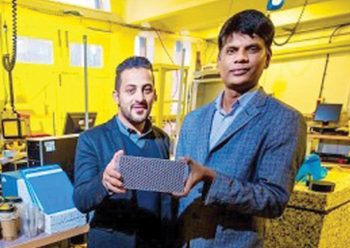Plastic brick offers ‘10 times better insulation’
01 December 2019
A team of researchers at the De Montfort University (DMU) in Leicester, UK, have created a brick entirely from domestic plastic waste that they claim has been proven to provide 10 times better insulation than traditional bricks made from clay.
The new brick is believed to be the first of its kind and has been made using 3D printing and lattice architecture technologies, which involves criss-crossing strips of the plastic materials to form a grid or weave, says a report on the DMU website.
The team was led by Dr Karthikeyan Kandan, senior lecturer in Mechanical Engineering at DMU, and included Saad Alqahtani, a first-year PhD student, and Dr Farukh, another senior lecturer in Mechanical Engineering at the university.
 |
|
The new brick (top) compared to a traditional brick ... 10 times better insulation. |
The brick’s design is inspired by nature, after Dr Kandan examined the structure of the Baya weaver bird’s nest, known for its elaborately woven construction.
“The Baya weaver bird’s nest’s ingenious construction gives it excellent thermal insulation and mechanical properties for inhabitation. Inside there is a central nesting chamber, which makes it the ideal micro-climate for inhabitation,” he explains.
He says by replicating this structure, they manufactured a brick that improves energy efficiency of modern buildings and, therefore, can reduce carbon footprint.
Controlled experiments on the plastic bricks were carried out by Alqahtani, under the joint supervision of Dr Kandan and Dr Farukh. To test its thermal insulation characteristics, Alqahtani placed the brick in a hot-box calorimeter – used to measure the U-value of an object, which can be set up to simulate the regulatory standard for buildings.
U-value is a measure of the flow of heat through an insulating or building material: the lower the U-value, the better the insulating ability.
The results showed the new design delivered an impressive U-value of 0.25 W/sq m K. This is 10 times more effective than a clay brick, which delivers an average of 2.94 W/sq m K, he points out.
Traditionally, a range of building blocks are required to achieve the regulatory standard U-value, however, the newly designed plastic brick can achieve this on its own.
“Our brick, made from all kinds of domestic plastic waste – from coffee cup lids to plastic bottles – exhibits a tremendous thermal envelope over conventional building materials,” says Dr Kandan.
“This provides significant potential to not only improve the energy efficiency of modern buildings, but also to conserve space and reduce deadweight in multi-storey buildings,” Dr Kandan says.
Alqahtani, who is doing research with Dr Kandan and Dr Farukh, says the brick could lead to a new era of energy-efficient construction while tackling the issue of plastic pollution at the same time.
“Our work has demonstrated that 3D printed bricks made from household plastic waste are thermally far superior to existing bricks made in the market,” he explains. “This breakthrough can literally help us build the future.”
This project marks the second time this year Dr Kandan has been recognised for his work to repurpose plastic waste. In August, he made headlines when he created a prosthetic limb socket made from recycled plastic water bottles for amputee patients.
In September, Alqahtani was invited to showcase their work at the 39th International Workshop on Computational Mechanics of Materials in Dubrovnik, Croatia.
“It was a great opportunity to meet industry experts and tell people about our work,” he says. “The next step is to get the brick into commercial production, which we hope to do by the end of the year.”
“There is a constant drive for energy-efficient building materials so it is very exciting to know that our brick can outperform the thermal insulation of standard building materials by an order of magnitude,” Dr Kandan concludes.



